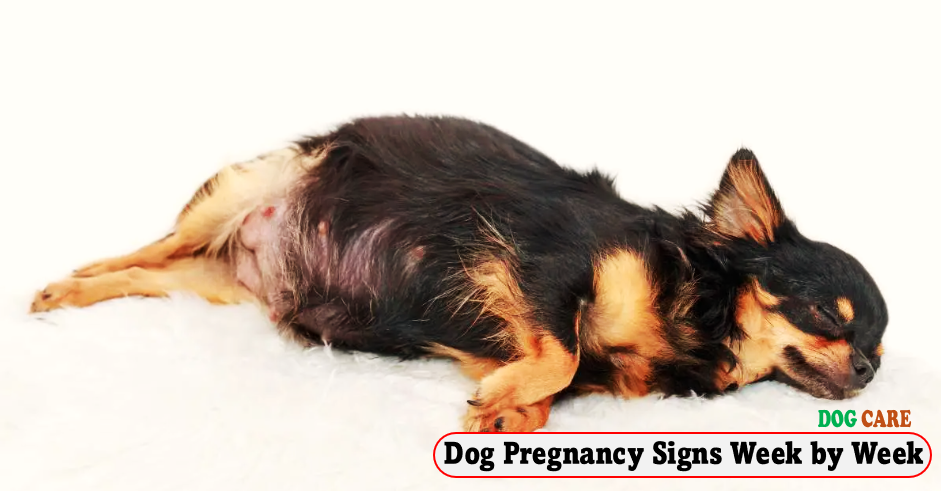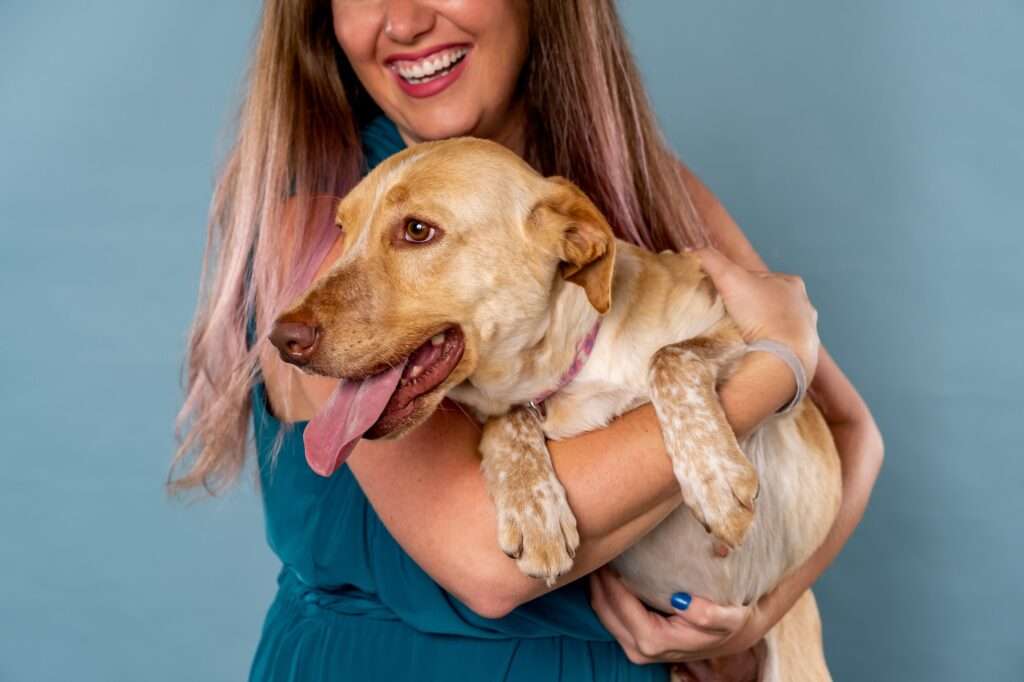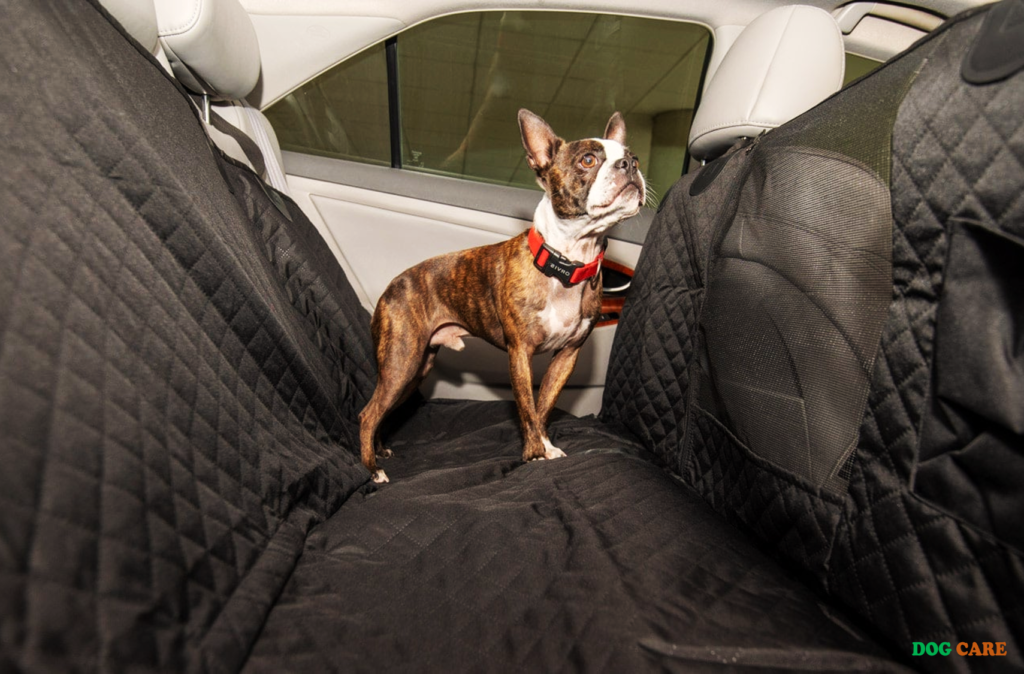Dog Pregnancy Signs Week by Week – Dog pregnancy generally lasts about 63 days, with signs like appetite changes in the first weeks and a growing abdomen by week four or five. Behavioral changes often occur early on, while increased nipple size becomes apparent as the pregnancy progresses.
Understanding dog pregnancy week by week enables owners to provide the best care. Early recognition of pregnancy in dogs is crucial for planning nutritional adjustments, preparing a whelping area, and scheduling vet visits. Dog owners might first notice a slight change in their pet’s behavior or appetite, which can signal the onset of pregnancy.
Around week four, a dog’s belly starts to expand and her nipples may become more prominent – these are strong indicators that puppies are on the way. As the weeks roll by, the mother-to-be requires more attention, and observing these changes closely ensures she remains healthy and the puppies develop properly. Every week brings new developments, and being informed helps owners navigate the journey from conception to birth with confidence.

Introduction To Canine Gestation
Greeting every pet parent with anticipation, understanding the journey through canine gestation is both fascinating and crucial for providing the best care. Just like humans, dogs experience a range of physical and behavioral changes during pregnancy that revealing sign of a new life blossoming within. From the moment of conception to the joyous day of delivery, every week brings new developments. In this detailed look at dog pregnancy, week by week, we’ll explore the signs and transformations our four-legged friends undergo as they prepare for motherhood.
Understanding Dog Pregnancy Basics
Dog pregnancy, or the gestation period, typically spans 9 weeks and is a time of significant change and development, encompassing the early signs of pregnancy to the whelping process. Familiarizing oneself with the fundamentals of canine pregnancy ensures caregivers can support their pets with informed care.
Key milestones to monitor include:
- Mating success: Confirming that mating has been successful is the first step.
- Hormonal changes: Observing the dog for hormonal variations that indicate pregnancy.
- Ultrasound confirmation: An ultrasound can confirm pregnancy as early as 25 days post-mating.
The Duration And Stages Of Dog Pregnancy
Canine pregnancy unfolds in stages over the course of approximately 63 days. The journey is typically divided into three stages—the early, middle, and final third, with each phase bringing its own set of developmental progress and physical changes.
| Stage | Timeframe | Developmental Milestones |
|---|---|---|
| Early Stage | Days 1-21 | Embryo implantation and early development |
| Middle Stage | Days 22-42 | Fetal growth, detectable heartbeat, increased appetite |
| Final Stage | Days 43-63 | Significant fetal growth, nesting behavior, whelping preparation |
Each week presents unique signs and behavioral cues that can aid the owner in gauging their dog’s progress and wellbeing. Stay tuned as we examine these changes, week by week, providing a comprehensive guide to expecting dog parents.
First Week: Fertilization And Early Signs
Welcome to the first and perhaps most mysterious stage of dog pregnancy: the initial week post-conception. As a pet owner, it’s natural to seek out the subtle changes that may indicate your furry friend is expecting. In the first week following successful mating, the signs can be almost imperceptible, but knowing what to look for can help you provide the best care from the very beginning. Let’s delve into what happens during the fertilization stage and the early signs that suggest the pitter-patter of puppy paws is on the horizon.
The Mating Process And Its Indicators
Understanding the mating process is crucial for recognizing the potential conception of a litter. Dogs are most receptive during their estrus cycle, commonly known as being in “heat.” During this time, you may notice your female dog—known as a bitch—exhibiting signs such as:
- A swollen vulva
- Vaginal bleeding or discharge
- Increased urination
- Behavioral changes such as restlessness or affectionate behavior
Male dogs also show interest in a female in heat by:
- Sniffing around more than usual
- Showing a keen interest in tracking the scent of the female
- Displaying mounting behavior
After the mating process, keep an eye out for the tie phenomenon, where the male and female dogs are locked together for a period—this is a sign that ejaculation has occurred and potentially, so has fertilization.
Post-mating Behavior And Expectations
Once mating has concluded, observing the changes in your dog’s behavior is pivotal. Post-mating, a female might seem either exceptionally affectionate or slightly more withdrawn, as individual temperaments can influence her behavior. The following behaviors could be indicative of a successful mating:
- Slight increase in appetite
- Subtle decrease in activity
- Nesting behaviors, although these are more commonly observed later in pregnancy
Physical signs such as a discolored or reduced discharge from the vulva might also be noticed shortly after mating. However, during the first week, it is exceptionally challenging to detect definitive signs of pregnancy through behavior alone. Vets typically cannot confirm pregnancy until after the second or third week through ultrasound or blood tests. Thus, while it’s vital to monitor your dog’s behaviors and physical condition, it’s also essential to remain patient and wait for more distinct indicators as the pregnancy progresses.
The observation and care given during the first week are more about preparation and ensuring your pet maintains good health, which will be invaluable for the weeks to come. Keep a closer eye on your canine companion, provide a nutritious diet, and establish a comfortable environment, as these early moments are seminal in both your lives.
Second Week: Cellular Development
As a dog owner, pinpointing pregnancy in the earliest stages can be tricky. However, during the second week, significant cellular development occurs as the foundation of new life is being laid. This is a critical period in your dog’s pregnancy where cells rapidly divide, forming the early embryo, which will eventually blossom into a new bundle of joy. While the changes are microscopic and not outwardly visible, there’s a lot happening beneath the surface. Let’s delve into the remarkable transformation taking place during this stage.
Early Embryonic Development
In the second week of dog pregnancy, the fertilized eggs continue developing into a cluster of cells known as a blastocyst. These cells specialize and organize into what will become various parts of the puppy’s body. It’s a rapid phase of growth that, while not yet causing physical changes in your dog’s appearance, is setting the stage for a successful pregnancy.
- The zygotes migrate to the uterine horns.
- Cellular differentiation initiates the formation of the puppies.
- Nutrient exchange begins as the cells prepare to attach to the uterine lining.
Possible Behavioral Changes In Your Dog
Behavioral shifts might start becoming noticeable around this time. Your dog may exhibit signs such as increased affection, a slight decrease in activity, or even a change in appetite. These early signals can sometimes be attributed to hormonal changes as the dog’s body prepares for the growth and nourishment of the embryos.
| Behavior | Changes | Explanation |
|---|---|---|
| Affection levels | Variation | Hormonal influence on mood |
| Activity | Decrease | Energy conservation |
| Appetite | Change | Adapting to embryonic development |
While these signs may be subtle, attentive dog owners might notice these early hints of pregnancy. It is important to monitor these changes and prepare for the subsequent phase, where physical signs will start to manifest more prominently.
Third Week: Embryo Implantation
The third week in a dog’s pregnancy is a critical time as it marks the beginning of an exciting process where the embryos implant themselves in the uterus lining. During this period of gestation, the fertilized eggs have completed their travel down the Fallopian tubes and now find a suitable spot within the uterus to settle. Understanding this stage is vital for dog owners who are keen on monitoring their pet’s pregnancy journey from the earliest moments.
Understanding The Implantation Process
Embryo implantation is a complex procedure that kicks off the actual pregnancy phase. Here’s how it unfolds:
- After conception, the embryos circulate within the uterus, seeking a nurturing environment to anchor.
- Around days 15 to 18, these embryos implant into the uterine lining, a process termed nidation.
- Following implantation, the embryos start to form the placenta, paving the way for essential nutrient and waste exchange with the mother.
- This period signifies an increased demand for nutrients. Adequate feeding ensures the developing embryos receive proper nourishment.
Understanding these details helps dog owners to better support their pets during these initial stages of pregnancy.
Physical And Behavioral Changes To Look For
Although it’s early in the pregnancy, there are a few indicative signs during the third week that owners might notice:
| Physical Changes | Behavioral Changes |
|---|---|
|
|
These changes are often subtle and not as pronounced as they will be in later stages. However, a vigilant owner might pick up on these early cues. A balanced diet and a peaceful environment can greatly assist a dog during this crucial time.
By the end of the third week of pregnancy, the groundwork for the future puppies is firmly in place, setting the stage for rapid development. It’s important to note that not all dogs show outward signs of pregnancy until much later. If in doubt, it is always wise to consult with a vet.
It’s crucial to ensure all content about dog pregnancy is accurate, detailed, and delivered in a way that is both informative and engaging to the reader. Additionally, maintaining SEO friendliness without sacrificing readability is essential.
Fourth Week: First Veterinary Visit
As your dog enters the fourth week of pregnancy, a critical milestone approaches. This time period is ideal for a first veterinary visit, which is vital for confirming the pregnancy and assessing the health of your soon-to-be mother canine. A timely check-up can provide essential insights and guide you to care for both the mother and her unborn puppies.
Why Schedule An Early Vet Appointment
Booking an early vet appointment during the fourth week of dog pregnancy serves multiple purposes. It allows for:
- Confirmation of Pregnancy: While physical signs might be minimal, a vet can verify pregnancy through palpation or ultrasounds.
- Health Check-Up: The vet assesses the overall health of the mother, ensuring she does not face any conditions that may affect her pregnancy.
- Nutritional Guidance: Adequate nutrition is vital. Your vet will recommend a diet that caters to the increased nutritional needs during pregnancy.
- Parasite Control: To protect the unborn puppies from parasites, the vet might suggest safe deworming methods appropriate at this stage.
Diagnostic Tests And What They Reveal
Several diagnostic tests are available to gain insights into your dog’s pregnancy:
| Diagnostic Test | Purpose | Information Revealed |
|---|---|---|
| Ultrasound | Confirm pregnancy and heartbeats | Verifies presence of embryos and assesses viability |
| Palpation | Feel for puppies | Estimates litter size (less accurate) |
| Blood Test | Check hormone levels | Confirms pregnancy and monitors hormone balance |
A thorough examination during this visit helps identify any anomalies early. With the right approach, preparations can be made for a smooth whelping process, setting the stage for healthy puppies.
Fifth Week: Noticeable Physical Changes
Welcome to a pivotal moment in your dog’s pregnancy journey—the fifth week. This phase marks a significant transition, characterized by remarkable physical changes that are both observable and measurable. It’s a time when dedicated dog owners, like you, can witness the wondrous transformation as the embryos grow and your dog’s body adapts to nurture new life. Let’s delve into the details and discover the fascinating developments during this critical period.
The Growth Of The Embryos
The fifth week of gestation is a period of rapid growth for the embryos. They are metamorphosing from mere clusters of cells to recognizable puppies, and their organs are beginning to take shape. Here’s a week-by-week glimpse into their development:
- Heartbeats can now be detected through an ultrasound.
- By this week, the limbs are forming, and the shape of the puppies becomes more defined.
- Although small, the embryos are gaining size significantly.
- Protective sacs and placentas have developed to provide essential nutrients to each puppy.
Visible Changes In Your Dog’s Appearance
During the fifth week, your dog’s body is undergoing visible changes that are easily perceptible:
- An increase in abdomen size becomes apparent as the embryos grow.
- Her nipples might enlarge, darken, and become more prominent due to the preparation for milk production.
- Some dogs may show changes in their coat quality, often becoming denser and shinier.
- Weight gain is expected; monitor her diet to ensure a healthy progression.
During this time, keep a close watch for any abnormal signs such as excessive weight gain or discomfort, and consult your veterinarian if any concerns arise. Nurturing your dog through this term is crucial for the well-being of both the mother and her unborn puppies.
Sixth Week: Preparing For Puppies
By the sixth week of a canine gestation period, signs of pregnancy become more evident. This stage signifies a shift from early pregnancy to the final preparation phase before the arrival of the puppies. The expectant mother dog starts displaying distinctive behaviors indicating that parturition (the act of giving birth) is approaching. Addressing her changing needs during this critical time is essential to ensure a healthy delivery and offspring.
Nesting Behaviors And How To Support Them
During the sixth week, you might notice your dog seeking secluded spots or rearranging her bedding—a behavior known as nesting. It’s an instinctive urge to create a safe, comfortable space for her pups. Here’s how to support this primal need:
- Provide a whelping box: Set up a comfortable area specifically designed for birthing, known as a whelping box, in a quiet and warm room of the house.
- Offer soft bedding: Line the whelping box with soft blankets or towels that are easily washable for maximum comfort and hygiene.
- Maintain privacy: Ensure the whelping area is away from busy parts of the home to give her peace as she prepares for labor.
Showing patience and providing support during this maternal preparation can greatly ease your dog’s stress as she approaches labor.
Dietary Adjustments And Nutrition
As delivery draws near, a pregnant dog’s nutritional needs intensify. Here are crucial dietary adjustments to consider:
| Week | Nutritional Focus | Action Steps |
|---|---|---|
| Sixth Week | Increased Caloric Intake | Gradually increase her food intake to support growing puppies. Aim for a diet rich in proteins and fats. |
| Calorie-rich Meals | Consider smaller, more frequent meals to accommodate her reduced stomach capacity. | |
| Hydration | Ensure continuous access to fresh water, as good hydration is paramount for a healthy birth process. |
Consulting with your vet for a tailored feeding plan is advisable as overfeeding can cause problems for both mother and puppies. Additionally, prenatal vitamins might be recommended to support the health of the mother and her developing litter. Careful monitoring and expert advice are key to maintaining optimal health during this late stage of dog pregnancy.
Seventh Week: The Homestretch
Entering the seventh week of dog pregnancy marks a significant milestone in the journey to motherhood for your beloved pet. This period is truly the homestretch, with the anticipation of new life heightening for both the expecting dog and her human family. Physical and behavioral changes become more pronounced, and preparations for the impending births enter their final stages.
Preparing Your Home For The New Arrivals
Now is the crucial time to ensure your home is ready to welcome your dog’s new puppies. Here are essential steps to consider:
- Create a whelping area: Choose a quiet, warm, and comfortable space where your dog can give birth and nurse her puppies without disturbances.
- Whelping box setup: Ensure the whelping box is large enough for your dog to move around, and line it with clean, soft bedding that’s easy to replace.
- Gather necessary supplies: Have plenty of towels, scissors, a thermometer, and a suction bulb on hand to assist with the delivery if necessary.
- Puppy-proof your home: This is also an excellent time to start puppy-proofing your home by securing loose wires and removing anything that small puppies could accidentally ingest or get hurt by.
Monitoring For Complications
As the due date approaches, monitoring your dog for any signs of complications is critical. Here’s what to keep a watchful eye on:
| Sign | What to Do |
|---|---|
| Drop in body temperature: | Temperature monitoring is vital. A drop below 99°F typically indicates labor will begin within 24 hours. |
| Behavior changes: | Look for signs such as restlessness, nesting behavior, or withdrawal as labor approaches. |
| Lack of appetite: | It’s common for appetite to decrease, but ensure she is still drinking water and staying hydrated. |
| Discharge: | Some discharge is normal, but contact your vet if it appears greenish-black or has a foul odor, as it could indicate infection. |
If you notice anything out of the ordinary such as excessive panting, pacing, or if your dog seems in distress, do not hesitate to contact your veterinarian. They can provide guidance and ensure that the whelping process is as smooth as possible for both the mother and her puppies.
Eighth Week: The Onset Of Labor
Reaching the eighth week of a dog’s pregnancy is a critical moment for any expectant canine owner. This last phase marks the final stretch of the gestation period, and it’s characterized by the onset of labor. During this time, it’s vital to recognize the impending signs of delivery and to ensure a safe and comfortable environment for your dog to give birth. Observing physical and behavioral changes will prepare you for the big event. As anticipation builds, stay informed on what to expect and how to support your furry friend.
Signs That Labor Is Imminent
As the due date approaches, your dog will exhibit specific signs indicative of labor. It is essential to observe these closely as they’re the body’s natural signal that puppies are on their way. Some key changes to look out for include:
- Drops in body temperature: Typically, a dog’s temperature will drop below 99°F (37.2°C) about 24 hours before labor.
- Behavioral changes: Dogs may seem restless, anxious, or more affectionate as labor nears.
- Nesting behavior: The instinct to prepare a safe place for delivery leads to dogs arranging bedding or seeking seclusion.
- Decreased appetite: It’s common for dogs to skip meals or eat less as they get closer to labor.
- Visible contractions: Watch for stomach movements that signify the beginnings of contractions.
- Discharge: A clear or slightly colored discharge might occur just before labor commences.
Creating A Comfortable Labor Environment
To aid your dog through the labor process, create a conducive birth setting with these steps:
- Select a quiet area: Find a space away from noise and household activity.
- Prepare a whelping box: Equip the area with a comfortable box lined with clean, soft bedding.
- Maintain warmth: Ensure the space is adequately heated, especially important for newborn pups.
- Accessibility: Keep the area easily accessible for you to provide assistance if necessary.
- Stock necessary supplies: Have clean towels, scissors, a bulb syringe, and iodine ready.
By watching for these crucial signs and setting the right environment, you can help herald a smooth and safe delivery for your beloved dog and her new litter of puppies.

Post-birthing Care
Post-Birthing Care is a crucial aspect when it comes to breeding dogs. Once the puppies are safely delivered, the focus shifts to ensure both the mother and her newborns receive appropriate care to thrive. This care begins immediately after birth and continues for several weeks to monitor both the physical and emotional well-being of the mother and her puppies. In the following sections, we’ll discuss essential care strategies for the new mother and her pups.
Caring For The New Mother
The well-being of the new mother is paramount in the immediate post-birthing phase. Proper nutrition, rest, and medical attention are the cornerstones of postpartum care:
- Provide comfortable bedding to allow for rest and recovery, and position it in a quiet part of the house.
- Ensure she has continuous access to fresh water and is offered a high-quality diet for breastfeeding.
- Monitor her for signs of complications such as excessive bleeding, fever, or behaviors that could indicate pain or distress.
Keep her environment clean and serene, as stress can impact her health and ability to nurse her puppies.
Ensuring The Health And Well-being Of The Puppies
Puppy care is a round-the-clock commitment that involves monitoring their development and ensuring they stay healthy:
| Week | Checklist for Puppy Care |
|---|---|
| Week 1 |
|
| Week 2 – 3 |
|
| Week 4 – 6 |
|
Regular vet check-ups are essential to check for congenital conditions and to administer vaccinations at the appropriate times. Be observant for any signs of illness such as lethargy, refusal to eat, or signs of discomfort which require immediate veterinary attention.
Frequently Asked Questions For Dog Pregnancy Signs Week By Week
What Are Early Dog Pregnancy Symptoms?
Early signs of dog pregnancy may include changes in appetite, increased nipple size, more affectionate behavior, and slight weight gain.
Can Dogs Show Pregnancy Signs By Week Two?
By week two, some dogs may show subtle signs like reduced activity levels, although it’s often too early for clear symptoms.
How Does A Dog’s Behavior Change In Pregnancy?
A pregnant dog might exhibit behavior changes such as increased affection, nesting behaviors, and a desire for more solitude.
What Week Do Dogs Start To Show?
Many dogs start to physically show pregnancy signs around week four or five with a slightly swollen belly and weight gain.
How Does Appetite Fluctuate During Dog Pregnancy?
Appetite fluctuations vary; some dogs eat more enhancing weight gain, while others may have reduced appetite in early stages.
Are There Visible Dog Pregnancy Signs By Week Three?
Visible signs at week three are minimal, but some dogs may have slight abdominal firming and behavioral changes indicating pregnancy.
What Physical Changes Occur In Week Five Of Dog Pregnancy?
In week five, dog pregnancy is marked by visible abdomen enlargement, increased nipple size, and potentially the start of milk production.
Can You Feel Puppies Move In Week Six?
By week six, it’s possible, though not certain, to feel the puppies move, especially during quiet moments.
What Care Is Needed During Week Seven Of Pregnancy?
Facilitate a peaceful, comfortable environment in week seven, as the dog prepares for birth with increased nesting activity.
How Does Whelping Begin In Week Nine?
Week nine usually culminates in whelping, signaled by the dog’s body temperature drop, restlessness, and nesting behavior intensifying.
Conclusion
As your dog’s pregnancy advances, staying informed is crucial. Each week, subtle changes signal new stages in your furry friend’s journey. Monitor these signs closely; they guide you in providing unparalleled care. We hope this week-by-week guide empowers you to support your dog through a healthy, happy pregnancy.


